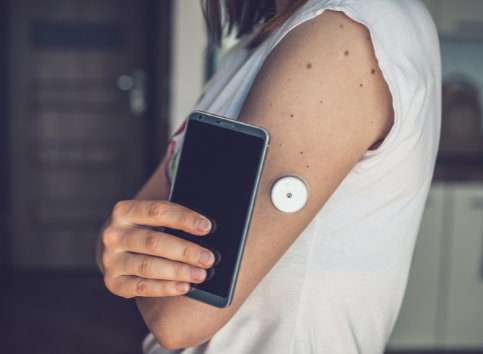Closed loop system to treat type 1 diabetes: everything there is to know!
Published Nov 14, 2023 • By Candice Salomé
Also known as an artificial pancreas, the closed loop is a system for managing type 1 diabetes through automated delivery of insulin. Its aim is to keep normal blood glucose levels as stable as possible.
So what exactly is a hybrid closed loop system? How does it work? What are the advantages and the downsides of this system?
We explain it all in our article!

What is the hybrid closed loop system for managing type 1 diabetes?
The closed loop is a hybrid medical system designed to mimic the natural functioning of the pancreas, the organ responsible for producing insulin. Insulin is essential for regulating blood sugar levels.
Depending on the model, a hybrid closed loop system combines two or three components that communicate with each other:
- An insulin pump delivering insulin,
- A continuous glucose monitor (CGM),
- An algorithm that establishes the link between the insulin pump and the CGM and which can be installed onto the pump or on a control unit such as a smartphone. It records blood glucose results from the CGM as well as the information provided by the patient (meals, snacks, physical activity), and then calculates insulin requirements so that it can be administered by the pump.
It's called a "hybrid" system because the patient still has to count the carbohydrates in their food and program the additional insulin doses to be administered when they eat or exercise.
How does the closed loop system for type 1 diabetes work?
The closed loop system automatically measures and adjusts the insulin delivery rate in the event of low or high blood sugar levels. If the monitor indicates a tendency towards hypoglycemia, the system stops the pump delivering the insulin. And if that's not enough, it alerts the patient with an audible signal so that they can 're-sugar'. Conversely, if blood sugar levels rise, the system instructs the pump to increase the dose of insulin administered. Again, if this is not enough, the patient is warned to check that the equipment is working properly and, if necessary, to make a manual correction.
The closed loop system couples an insulin pump with a continuous glucose meter and a computer program. This system then decides by itself how much insulin to deliver, exactly as the pancreas of a non-diabetic person would do. However, the insulin is still delivered by the pump.
What are the advantages of the closed loop system for managing type 1 diabetes?
Research has demonstrated that such hybrid systems improve diabetes management, reduce hypoglycemia and improve quality of life for patients with type 1 diabetes.
The closed loop system offers a number of advantages, including:
- Maintaining glycemic control over time, reducing the risk of hypoglycemia or hyperglycemia. This improvement helps prevent diabetes-related complications (cardiovascular disease, blindness, kidney failure, neuropathy and amputations).
- Reducing the mental burden associated with managing the disease, thereby improving the quality of life of patients and those around them.
- Reducing stress and anxiety associated with diabetes, improving patients' well-being and quality of life.
- Reducing the number of night-time awakenings, thereby improving patients' quality of sleep.
What are the drawbacks of the closed loop system for managing type 1 diabetes?
The closed loop system has a number of disadvantages which need to be taken into account:
- The patient must learn to use the closed loop system properly. They must learn to familiarize themselves with the settings of the device, the precise calculation of carbohydrates, the carbohydrate/insulin ratio, the timing of additional insulin injections, and the use of alarms. In addition, it is essential to learn to manage connection problems and software updates and to interpret the generated data.
- In addition, knowing how to manage daily life (physical activity, calorie intake) via the system, as well as hypoglycemia and hyperglycemia, is essential to be able to benefit from a successful diabetes management experience.
- The insulin pump cannula (a tube used to deliver insulin) must be changed regularly to minimize the risk of reduced insulin absorption and also to prevent the development of lipohypertrophy (abnormal growth of fat beneath the surface of the skin), which can affect insulin absorption and thus alter blood sugar regulation.
Key facts
The hybrid closed loop system is a medical device designed to mimic the natural functioning of the pancreas. This technology comprises 2 or 3 components, depending on the model: an insulin pump, a continuous glucose monitor (CGM), and an algorithm that establishes the link between them.
There are many benefits for type 1 diabetes patients, since the closed loop system greatly reduces the mental burden associated with managing diabetes and helps to improve quality of life.
If you'd like to find out more about the hybrid closed loop system, don't hesitate to talk to your primary care doctor or your diabetes doctor!
Share your thoughts and questions with the community in the comments below!
Take care!
Sources :
Les pancréas artificiels ou systèmes en boucle fermée, Dinno Santé
Le dispositif phare : la boucle fermée, Isis Diabète
Le guide des boucles fermées, La Belle et le Diabète
Boucle fermée pour traiter le diabète : qu’en est-il en France ?, Ettiko
Les boucles fermées – Pour qui ? Comment ?, Diabète & Obésité
Diabète : des technologies nouvelles pour un quotidien plus confortable, France Assos Santé
Le pancréas artificiel allège le fardeau du diabète, Medscape
Comments
You will also like

Diabetes: Discrimination, Professional Life, Plan Ahead... What do patients say?
Nov 9, 2018 • 9 comments

Fighting Schizophrenia Symptoms: a Long Journey Against Paranoia after Denial and being Admitted
Dec 12, 2018 • 6 comments

 Facebook
Facebook Twitter
Twitter